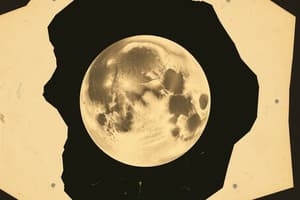Podcast
Questions and Answers
Match the following names with their roles or descriptions in 'The Great Moon Hoax':
Match the following names with their roles or descriptions in 'The Great Moon Hoax':
Dr. Andrew Grant = Alleged writer of the moon articles Sir John Herschel = Famous astronomer mentioned Richard Adams Locke = Real writer behind the hoax The New York Sun = Newspaper that published the articles
Match the following phrases with their corresponding features from the articles:
Match the following phrases with their corresponding features from the articles:
Unicorns = Described as life on the moon Amethyst crystals = Geographical feature of the moon Massive craters = Physical characteristic of the lunar surface Lush vegetation = Another element of moon's portrayal
Match the following dates with their significance in relation to 'The Great Moon Hoax':
Match the following dates with their significance in relation to 'The Great Moon Hoax':
August 25, 1835 = First article published January 1834 = Herschel traveled to South Africa September 16, 1835 = Admission of the hoax by The Sun Publication years before = End of Edinburgh Journal of Science
Match the following elements with their relevance to the public's reaction at the time:
Match the following elements with their relevance to the public's reaction at the time:
Match the following locations with their significance in the context of The Great Moon Hoax:
Match the following locations with their significance in the context of The Great Moon Hoax:
Match the following hypotheses in the articles with their characteristics:
Match the following hypotheses in the articles with their characteristics:
Match the following impacts with their respective consequences of 'The Great Moon Hoax':
Match the following impacts with their respective consequences of 'The Great Moon Hoax':
Match the following terms with their definitions related to the hoax:
Match the following terms with their definitions related to the hoax:
Flashcards are hidden until you start studying
Study Notes
The Great Moon Hoax
- On August 25, 1835, The New York Sun published a series of articles claiming scientific discoveries from the moon.
- Articles were purported to be written by Dr. Andrew Grant, a fictional colleague of astronomer Sir John Herschel.
- The series became extremely popular, generating widespread curiosity and excitement among readers across the United States.
Alleged Discoveries
- Descriptions included bizarre life forms such as unicorns, two-legged beavers, and human-like creatures.
- Detailed the moon’s geography with massive craters, amethyst crystals, flowing rivers, and lush vegetation.
Fabrication of the Hoax
- Dr. Andrew Grant and the Edinburgh Journal of Science were entirely fabricated; the journal had ceased publication years prior.
- No scientific evidence supported the claims made in these articles, making them entirely fictional.
Public Reaction and Impact
- Despite being entirely false, the stories captivated the public imagination, leading to a frenzy of interest.
- Artistic depictions emerged based on the descriptions, demonstrating the power of media to influence perception.
Authorship and Revelation
- The articles were likely written by Richard Adams Locke, a reporter at The Sun, who intended to create an entertaining narrative.
- The escalating absurdity prompted The Sun to eventually admit the deception on September 16, 1835, revealing it as a hoax.
Historical Context
- The incident foreshadows contemporary issues of "fake news," highlighting the long-standing susceptibility of readers to manipulated print narratives.
Studying That Suits You
Use AI to generate personalized quizzes and flashcards to suit your learning preferences.





